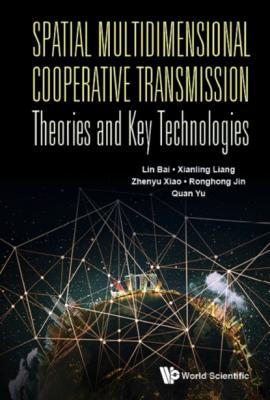Spatial Multidimensional Cooperative Transmission Theories And Key Technologies. Lin Bai
Читать онлайн.| Название | Spatial Multidimensional Cooperative Transmission Theories And Key Technologies |
|---|---|
| Автор произведения | Lin Bai |
| Жанр | Зарубежная компьютерная литература |
| Серия | |
| Издательство | Зарубежная компьютерная литература |
| Год выпуска | 0 |
| isbn | 9789811202476 |
First, we consider zero forcing (ZF) detection. The ZF detection linear filter is defined as
And the corresponding ZF signal is estimated as
With
It should be noted that since the noise term, namely the effect of (HHH)−1HHn in Eq. (2.148), will be amplified, the equivalent noise will be amplified when the channel matrix H is nearly singular. Therefore, the performance of the ZF detection cannot be well guaranteed. In order to reduce the influence caused by the equivalent noise being amplified in the ZF detection, the MMSE detection utilizes the statistical property of the noise to improve the ZF detection method. The calculation of the MMSE filter matrix is based on the minimum mean square error criterion.
where Es represents the signal energy. The corresponding estimate of the transmitted signal vector can be expressed as
Therefore, the MMSE hard decision
2.4.2.3Successive interference cancellation (SIC) detection
With the consideration of the existence of interference signals, how to realize high-performance signal detection has become a key issue that modern wireless communication needs to solve. For example, assume that the signal received by the receiver is
where si and hi represent the ith signal and the channel gain experienced by the signal, respectively, and n represents the background noise. When detecting the signal s1, the signal-to-interference plus noise ratio can be expressed as
where E[|si|2] = Ei and E[|n|2] = N0. If the received power of the two signals is assumed to be the same, namely E1 = E2, and the channel gain is also assumed to be the same, namely |h1|2 = |h2|2, then the SINR of signal s1 will be less than 0 dB, which brings great difficulty to the signal detection.
Successive interference cancellation is an alternative method to improve the performance of signal detection. Assuming E1 > E2, the SINR of s1 is relatively high at this time, and it is possible to detect s1 first. Let
This detection method is called Successive Interference Cancellation (SIC) and can be applied to MIMO joint signal detection.
In order to realize SIC, QR decomposition plays an important role in the SIC-based detection process.10, 11 QR decomposition is a common method of matrix decomposition, which can be decomposed into the product of an orthogonal matrix and an upper triangular matrix. And how the 2 × 2 MIMO system performs QR decomposition will be introduced first in this section.
Assume that there is a 2 × 2 channel matrix H = [h1 h2], where hi represents the ith column vector of H. Define the inner product of the two vectors to be
where
According to the linear relationship described by Eq. (2.154), it can be judged that [h1 h2] and [r1 r2] can span the same subspace. And if ri is a non-zero vector (i = 1, 2), it can be found that
where qi = ri/||ri||. Based on Eq. (2.156), an orthogonal matrix Q = [q1 q2] and an upper triangular matrix
The successive interference cancellation of the received signal can be performed according to the QR decomposition of the channel matrix. This section only discusses the case where the channel matrix H is a square matrix or a thin matrix (M ≤ N) whose number of rows is larger than the number of columns.
1. H is a square matrix
H can be decomposed into an M × M unitary matrix Q and an M × M upper triangular matrix R.
where rp,q is defined as the (p, q)th element of R. By the premultiplication of QH, the received signal can be expressed as
where QHn is a zero-mean CSCG random vector. QHn has the same statistical property as n, and hence, n can be used directly to replace QHn. As a result, Eq. (2.158) can be transformed into
If xk and nk are defined as the kth
